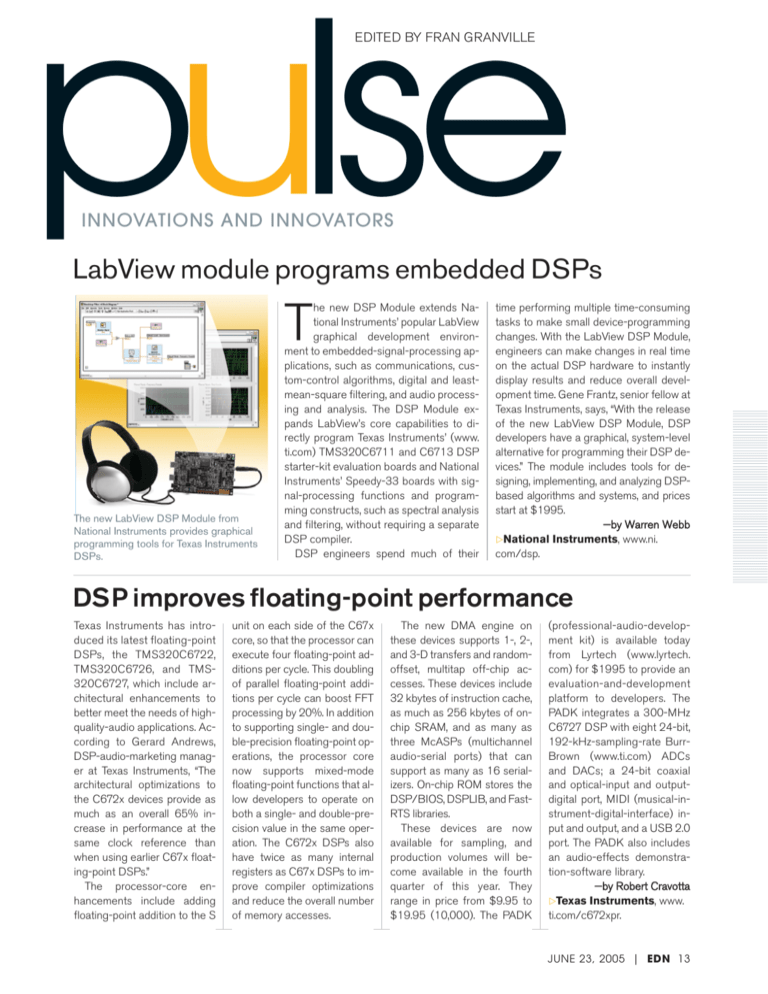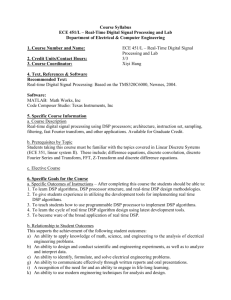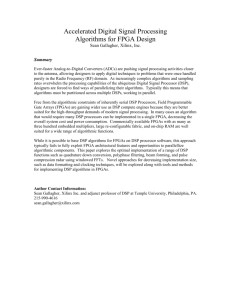LabView module programs embedded DSPs
advertisement

pulse EDITED BY FRAN GRANVILLE INNOVATIONS AND INNOVATORS LabView module programs embedded DSPs he new DSP Module extends National Instruments’ popular LabView graphical development environment to embedded-signal-processing applications, such as communications, custom-control algorithms, digital and leastmean-square filtering, and audio processing and analysis. The DSP Module expands LabView’s core capabilities to directly program Texas Instruments’ (www. ti.com) TMS320C6711 and C6713 DSP starter-kit evaluation boards and National Instruments’ Speedy-33 boards with signal-processing functions and programming constructs, such as spectral analysis and filtering, without requiring a separate DSP compiler. DSP engineers spend much of their T The new LabView DSP Module from National Instruments provides graphical programming tools for Texas Instruments DSPs. time performing multiple time-consuming tasks to make small device-programming changes. With the LabView DSP Module, engineers can make changes in real time on the actual DSP hardware to instantly display results and reduce overall development time. Gene Frantz, senior fellow at Texas Instruments, says, “With the release of the new LabView DSP Module, DSP developers have a graphical, system-level alternative for programming their DSP devices.” The module includes tools for designing, implementing, and analyzing DSPbased algorithms and systems, and prices start at $1995. —by Warren Webb 컄National Instruments, www.ni. com/dsp. DSP improves floating-point performance Texas Instruments has introduced its latest floating-point DSPs, the TMS320C6722, TMS320C6726, and TMS320C6727, which include architectural enhancements to better meet the needs of highquality-audio applications. According to Gerard Andrews, DSP-audio-marketing manager at Texas Instruments, “The architectural optimizations to the C672x devices provide as much as an overall 65% increase in performance at the same clock reference than when using earlier C67x floating-point DSPs.” The processor-core enhancements include adding floating-point addition to the S unit on each side of the C67x core, so that the processor can execute four floating-point additions per cycle. This doubling of parallel floating-point additions per cycle can boost FFT processing by 20%. In addition to supporting single- and double-precision floating-point operations, the processor core now supports mixed-mode floating-point functions that allow developers to operate on both a single- and double-precision value in the same operation. The C672x DSPs also have twice as many internal registers as C67x DSPs to improve compiler optimizations and reduce the overall number of memory accesses. The new DMA engine on these devices supports 1-, 2-, and 3-D transfers and randomoffset, multitap off-chip accesses. These devices include 32 kbytes of instruction cache, as much as 256 kbytes of onchip SRAM, and as many as three McASPs (multichannel audio-serial ports) that can support as many as 16 serializers. On-chip ROM stores the DSP/BIOS, DSPLIB, and FastRTS libraries. These devices are now available for sampling, and production volumes will become available in the fourth quarter of this year. They range in price from $9.95 to $19.95 (10,000). The PADK (professional-audio-development kit) is available today from Lyrtech (www.lyrtech. com) for $1995 to provide an evaluation-and-development platform to developers. The PADK integrates a 300-MHz C6727 DSP with eight 24-bit, 192-kHz-sampling-rate BurrBrown (www.ti.com) ADCs and DACs; a 24-bit coaxial and optical-input and outputdigital port, MIDI (musical-instrument-digital-interface) input and output, and a USB 2.0 port. The PADK also includes an audio-effects demonstration-software library. —by Robert Cravotta 컄Texas Instruments, www. ti.com/c672xpr. JUNE 23, 2005 | EDN 13 Lithography simulator helps designers check integrity of OPC layouts hotolithography-toolvendor Sigma-C contends that your OPC (optical-proximity-corrected) design may not be correct at all. The Munich-based vendor has expanded into the design-formanufacturing tool market with the new Solid microlithography simulator that lets IC designers know whether photoresist equipment can accurately print their OPC-IC layouts. Sigma-C based the new tool on its Solid line of lithography-optimization tools. Those tools draw on a database that characterizes equipment, materials, and processes and helps lithography engineers simulate and derive manufacturing processes. The company will show Solid next month at the Design Automation Conference in Anaheim, CA. The tool uses the same database and lithography models as Solid to ensure that simulations accurately correlate with the process. However, Solid targets chip and cell designers and allows them to tell during chip and cell development whether their designs, OPC layouts, and ORC (optical-rule-checking) tools are process-accurate, says Thomas Blaesi, vice president of marketing and business development. P DILBERT By Scott Adams 14 EDN | JUNE 23, 2005 Peter Feist, Sigma-C’s chief operating officer, explains that, at the 90-nm node, OPC becomes a must at all layers and that the 65-nm node is taxing for traditional OPC and ORC tools. To ensure OPC layouts are process-accurate requires simulation with Solid. “SigmaC’s goal is to help the semiconductor industry bridge the gap between design and printedwafer results and ultimately prevent mask failure at 65 nm and below,” he says. “A lot of masks are failing because models used in OPC are inaccurate,” says Blaesi. “We reproduce the real expected pattern on the wafer. Solid lets design engineers verify their patterns at these smaller process nodes, which masks can then accurately reproduce.” The 3-D technology uses an analytical-resist, rather than a numerical, model like competing OPC tools and thus has Spicelike accuracy with the ability to simulate aerial images to the macro level and resist images to the cell level. The tool’s engine simulates cells as large as 100 100 microns. “There is an opportunity to become the golden tool in the industry to help other tools calibrate their models,” Blaesi says. Users will feed the tool GDSII files, and the tool exports resist profiles in a GDSII layer with defect information. The initial release forces users to manually adjust OPC models and layouts, but a lot of opportunities exist to automate that process, according to Blaesi. Solid and Solid both use the same database and same manufacturing models, which allows manufacturing to share up-to-date process information with designers targeting their designs at an evolving process. The company expects to have the technology ready for commercial use in the fourth quarter of this year. —by Michael Santarini 컄Sigma-C, www.sigma-c.com. FEEDBACK LOOP “It always drives me up the wall when almost none of the experts taking positions on engineering decisions has any background in any technical subject.” Gordon Young, in EDN’s Feedback Loop at www.edn.com/ article/CA526328. Sampling downconverter module meets need for serious speed The trend in radar receivers and similar advanced systems is to replace the traditional mixer with a downconversion-sampling module that comprises the front end of the digitalsignal-processing chain. One such family of products, the 7600 series from Picosecond Pulse Labs, provides 25-GHz RF bandwidth with a sampling rate of 10M samples/ sec to 2G samples/sec. Maximum harmonic distortion with a 0dBm RF input is 55 dBc, and aperture jitter does not exceed 250 fsec rms. The RF input and IF output each use a 2.92mm, single-ended female connector. The local-oscillator signal is either single-ended or differential; the differential signal yields lower jitter. The sampler module, available as a pc board, includes a two-stage IF amplifier and dissipates 5W; it meets military-standard airborne and naval environmentaloperating requirements. Board configurations include one-, two-, and four-channel VME and CompactPCI formats, and prices are $9995 to $31,995. —by Bill Schweber 왘Picosecond Pulse Labs, www.pico second.com. 06.23.05 pulse pulse Microcontroller-based SOC marries wireless and configurableanalog capabilities or the past few years, Cypress has touted two product families that it is now integrating in the PRoC (Programmable Radio-on-aChip) family. PRoC devices will include both the 2.4-GHz wireless radio that Cypress offers in its WirelessUSB family and the microcontroller-based PSOC (programmable system-onchip) that includes flexible analog capabilities, such as data converters and filters. The first PRoC offering will sell for as little as $3.50 (high volumes). It offers 8 kbytes of flash memory, 512 bytes of SRAM, and a mixed-signal array with four programmable analog blocks and four programmable digital blocks. Cypress has succeeded in selling the WirelessUSB family into a variety of HID (human-interface-device) applications, such as wireless keyboards and remote controls. The company believes that the PRoC family can implement such products and serve even in higher performance roles. For instance, Cypress projects the use of PRoC in high-end home remote controls and in remote-controlled toy planes and cars. Any number of industrial-control and -automation applications might also prove apt targets. Cypress officials believe that WirelessUSB offers a simpler and cheaper alternative to technologies such as Zigbee in control applications. WirelessUSB lacks the complex Zigbee software stack and mesh-network capability. But WirelessUSB can connect devices at distances of 10 to 50m, and configuring the nodes of a network requires only that the de- F 16 EDN | JUNE 23, 2005 signer place two devices directly next to one another, so that the Cypress Kissbind technology can establish the wireless associations. The company will also offer development tools and reference boards to support designs customers base on the chip. by Maury Wright —b 컄Cypress Semiconductor Corp, www.cypress.com. FEEDBACK LOOP "I don't consent to the manufacturer's monitoring of me, or my car, even how my car performs--particularly under the guise of improving their product. The type of invasive process this ‘black box’ represents right now needs to be stomped out, by law if necessary." "Bureau Crat," in EDN's Feedback Loop at www.edn.com/article/CA529380. Logic analyzers feature higher speed and bigger screens and squeak to No. 1 in market share Tektronix is crowing that, after years of battling, its logic analyzers have finally squeaked past those of Agilent Technologies (www.agilent.com) to achieve the No. 1 market share in 2004, according to a Prime Data (www.primedata. com) study. Eight years earlier, Tek’s logic-analyzer market share was less than one-third of last year’s 50%. To emphasize that it is not resting on its laurels, Tek has announced two new units in its TLA7000 series: the $14,000, portable TLA7012, which accommodates as many as 272 channels, and the $16,000, benchtop TLA7016, which accommodates as many as 816 channels. The TLA7012 incorporates a 15-in.-diagonal, 1024728-pixel touchscreen LCD and a PC based on a 2GHz Pentium M processor running Windows XP Professional. The analyzer can also drive two external, side-by-side, 1600 1200-pixel monitors, to create, in effect, a double-width display with a 3200-pixel horizontal resolution. The TLA7016 The most immediately obvious feature of the 272-channel (maximum) TLA7012 logic analyzer is the 15-in.-diagonal, high-resolution LCD. requires a separate PC and one or two monitors. The logic-analyzer software (TLA application software Version 5.0) also runs on earlier TLA-series units that can run either Windows XP Professional or Windows 2000. Owners of such units can upgrade the analyzer software or trade in their instruments. Tektronix is also accepting competitive analyzers in trade. Among Version 5.0’s new features are drag-and-drop triggering, automated measurements, and a user interface that features tabbed TLA Explorer windows, which permit one-click navigation to the window of interest, such as trigger, setup, waveform, or listing windows. —by Dan Strassberg 컄Tektronix Inc, www.tek tronix.com. Compression technique preserves accessible data elements ike all other compression technologies, WindSpring’s DMT (dataminiaturization technology) shrinks data sets, thereby reducing storage requirements and the accessing or transmitting time necessary to fetch data. But DMT differs from most other lossless-compression techniques in that the data elements that constitute a compressed file maintain a one-toone relationship with the data elements in the original file. This approach means that an application such as a mapping program can manipulate elements within a compressed map without decompressing the entire file and therefore without the requirements of a memory bank that can handle the decompressed file. WindSpring’s technology does not work on all data types. You can’t use it to compress MP3 music or JPEG image files, for instance. But for files ranging from text documents to maps, DMT may L prove a perfect match for PDAs, automobile systems, and other memory- and storage-constrained applications. You apply the DMT codec to a data file, resulting in the creation of a sequence dictionary and the new file in an MDF (microdata format). The company claims that you will realize typical compression ratios of 3-to-1 on text files, 6-to-1 on XML files, and as much as 10-to-1 on map files. The company will market the technique in two ways. WindSpring Gazelle targets OEM-device manufacturers and application developers and sells for $25,000 plus royalties. The product supports the Windows, Linux, Qualcomm Brew, and PocketPC operating systems. End users, meanwhile, can buy WindSpring Mobile for the PocketPC for $24.95. —by Maury Wright 컄WindSpring Inc, www. windspring.com. Zigbee chip and software stack enable control networks Someday, users will recognize control networks as equally important as—if not more important than—the more glamorous data network in the home. Low-speed control networks will enable a truly smart home with automated HVAC systems and lighting control. And it’s not all about luxury. That same control network might link a home-security system or even smart medical devices. 18 EDN | JUNE 23, 2005 Zigbee is the leading candidate to form the foundation of wireless-control networks, and fully integrated Zigbee chips are finally ready. Ember Corp, for instance, just announced a full Zigbee implementation with a microcontroller and memory to handle application code. Moreover, the EM250 SOC (system on chip) will cost less than $4 (high volumes). Module combines mobile communications, GPS Parvus Corp recently announced the OrbiTrak GSM (Global System for Mobile communications), a PC/104 module for intelligent-vehicle and airborne-computing systems requiring worldwide GSM/GPRS (General Packet Radio Service) roaming and GPS (global-positioning-system) positioning. The module combines a Siemens (www.siemens.com) 900/1800/1900-MHz MC45 GSM/GPRS wireless modem with a 12-channel, low-power iTrax02 GPS receiver supporting NMEA (National Marine Electronics Association) and Binary protocols. The compact 3.5503.775-in. PC/104 form factor sustains high mechanical stress and thermal shock and operates at extended temperatures. Supporting full interrupt-sharing for all of its serial ports, the board includes a four-channel 16C550 UART with two RS-232 serial ports open for other devices. EEPROM-board-configuration settings eliminate banks of interrupts and base-address jumpers. A 16bit-wide programmable digital I/O interfaces to lowpower digital devices, and two automotive-level digital inputs connect to 12 or 24V digital signals. A headsetaudio-interface port supports user voice communications. Designers can install a standard SIM (subscriber-identity-module) card into the board’s onboard locking cardholder. The Targeting demanding module will become available mobile-communicaearly in the third quarter of this tions and global-posi- year, and prices will range from tioning applications, $298 to $398 each (100 units or the OrbiTrak GSM ofmore).—by Warren Webb fers a 12-channel 왘Parvus Corp, www.parvus. GPS plus a triband GSM/GPRS modem. com. The EM250 integrates a proprietary16-bit microcontroller that the company claims requires the silicon footprint of a typical 8-bit 8051 core. The 16-bit design is key to handling 16-bit Zigbee network addresses. Venkat Bahl, Ember’s vice president of marketing, also points out that the 1-Asleep-power spec of the EM250 will be important in Zigbee applications. According to Bahl, many Zigbee products will be powered on less than 1% of their life, so low sleep power is more im- portant than low active power. Ember also offers the EmberZNet Zigbee software stack to its chip customers, along with an integrated development environment. For customers who want just a Zigbee-interface chip, Ember will roll out the EM260 just after the EM250. The EM260 will cost even less, and users can employ it with external processors from Texas Instruments (www.ti. com) and Atmel (www.atmel. —by Maury Wright com).— 컄Ember Corp, www.ember. com. 06.23.05 pulse R E S E A R C H U P DA T E BY BILL SCHWEBER “Plastics” return to original meaning, but with light he word “plastic” originally characterized only the material’s qualities: It is malleable, pliable, and deformable. Now, researchers at the Massachusetts Institute of Technology have developed plastics that change shape when the researchers exposed them to specific wavelengths and return to their original shape when the researchers exposed them to other wavelengths. Although materials that deform and return to original shape in response to temperature have been available for many years, such thermoplastics are not sensitive to light. The new class of plastics could find use in light-driven T medical devices that change to their final shape after implantation into a body and then become active using light and an optical fiber. The light-sensitive plastic uses photosensitive polymer switches in a film, which the researchers stretched with external stress and then exposed to UV light. The light causes the switches to cross-link, or bind, to each other. The cross links remain when a user turns off the light and change their structure when light energizes the links. For more information, go to http://web.mit.edu/ newsoffice/2005/print/ smart-plastics-print.html. 컄Massachusetts Institute of Technology, www.mit.edu. Nanograss provides effective thermal-transfer surface Cooling is a constant design challenge. To meet that challenge, researchers at Bell Labs/Lucent are experimenting with a nanostructured surface that reduces viscous drag on cooling fluid. The intention is to use billions of silicon posts to aid in transferring heat from the silicon surface to the liquid coolant. Each post has a water-repellent, Teflonlike surface, so fluids flow without wetting. When researchers apply a small electric current to the posts, the droplets on the surface slick down and wet the surface. This technology allows researchers to study the details of fluid flow and heat transfer across such superhydrophobic surfaces. The nanograss also provides a tenfold increase in the effective surface area of a flat silicon surface, which also facilitates heat transfer. Find more details at www.lucent.com/press/0305/050307.blb.html. 컄Lucent Technologies, www.lucent.com. A wave of nanograss surface enhances thermal transfer from heat source to cooling fluid and reduces viscous drag that can severely impede fluid flow. 20 EDN | JUNE 23, 2005 White LEDs get hotter—in intensity Researchers at Rensselaer Polytechnic Institute’s Lighting Research Center have come up with a way to achieve a development priority: extracting more light from white LEDs. With their scattered-photon-extraction approach, they move the phosphor that produces the visible white light away from the semiconductor and shape the LED lens’ geometry. As a result, photons that the LED normally absorbs internally—typicalA fixture using LEDs ly, more than half the LED’s outthat incorporate scatput—can escape as visible light. tered-photon extraction shows the intensi- The RPI researchers claim that ty of the white output. the technique offers 30 to 60% better light output and luminous efficacy than standard commercial white LEDs provide. For further details, go to http://news.rpi.edu/update. do?artcenterkey697&setappvarpage(1). 왘Rensselaer Polytechnic Institute, www.rpi.edu. MEMS assists microdetectives MEMS (microelectromechanical systems) have the versatility to solve specialized problems, and the demonstration of that versatility continues at Sandia National Laboratories. Researchers there have devised an advanced gas-sampling procedure using picoliters of gas to check whether the atmosphere inside a MEMS device is pure. A small commercial valve crushes a tiny object—the MEMS chip under investigation—and feeds the released gases to a custombuilt intake manifold. Because the test mechanism requires only picoliters of gas, it can re-evaluate dozens of times, using bursts of puffs of gas that it receives. This repetition increases the final test’s validity due to the repeated sampling and testing during a 20-minute period, compared with the uncertain validity of a single test and result. For more details, go to www.sandia.gov/ news-center/news-releases/2005/mat-chem/smallatmost.html. 컄Sandia National Laboratories, www.sandia.gov. A MEMS test unit sits under the black box that contains its atmosphere. The gold plates are wiring sites, and the translucent cubes around the device are grains of salt. 06.23.05 pulse






